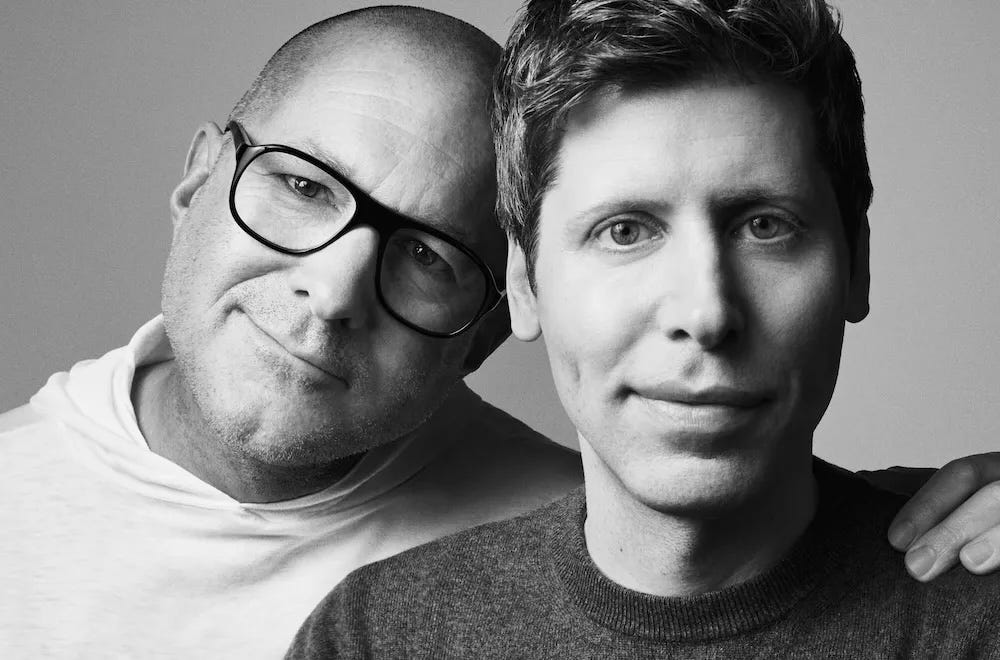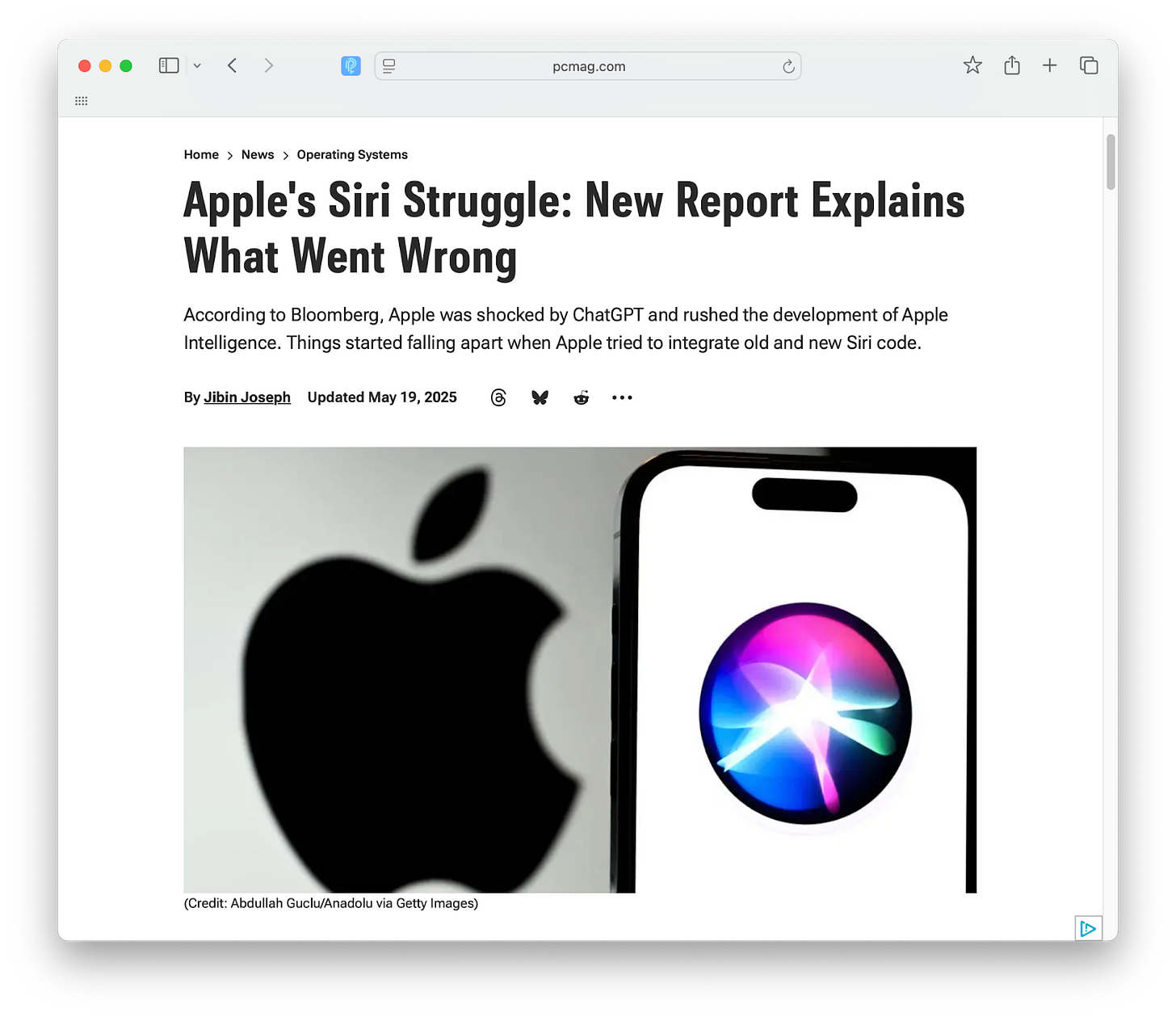(#127) 🤖 OpenAI & ex-Apple = LOVE; on Google I/O 2025
🍏 Why Apple hasn’t cracked AI…yet
Dear #onStrategy reader,
Here is what you’ll find in this edition:
🤖 OpenAI + ex-Apple = LOVE
🍏 Why Apple hasn’t cracked AI…yet
🛰️ Lessons from go-to-market. A case study from Starlink
🟡🟢🔵🔴 Google I/O 2025
On to the update:
OpenAI + ex-Apple = LOVE
There’s a new bromance in town: Jonny Ive and Sam Altman.
1/ When OpenAI announced it was acquiring Jony Ive’s AI hardware company for $6.5 billion, the headline hinted towards the kind of future they want to design. This isn’t a chatbot play. It’s a frictionless computing moonshot. As I argued in my essay “Artificial Intelligence: Towards a Frictionless World”, the next leap in tech it’s about removing the invisible friction between humans and machines. What Ive and Altman are building isn’t an iPhone killer; it’s a new species of interface, something that doesn’t just fit in your hand but folds into your life.
2/ Look closely and the pieces are all here. A stealth team of ex-Apple hardware leaders, a design-first product ethos and Altman’s clear belief that AI needs its own form factor to reach full expression. Humane and Rabbit tried and failed to do this, because they shipped too early and too thin. Ive and Altman are taking their time. The hints point to something ambient: glasses, perhaps, or a home hub that listens, reasons and acts. It’s less a gadget and more a presence. And yes, the internet removed friction for information. This is about removing friction from cognition itself.
3/ The reason this matters is that it reframes AI as not just “software you type into”, but as an experience you live with. Interfaces will become assistants, appliances will become agents. And instead of a dozen apps on your phone, you’ll have one system around you which will be context-aware, generative and invisible. That’s OpenAI’s hardware roadmap. The first product is due in 2026, but the real disruption has already started: the AI layer is becoming physical. And this time, it might actually be beautiful. Bloomberg, OpenAI
Why Apple hasn’t cracked AI…yet
1/ Apple’s AI journey is starting to feel like a very expensive keynote demo gone wrong. The company spent seven years and billions trying to catch up with OpenAI, Google and the rest only to ship Siri upgrades so delayed and buggy they had to be quietly pulled from iPhones and pulled even more quietly from YouTube ads. Internally, it’s a swirl of “too little,” “too late,” and “let’s maybe just call ChatGPT.” Apple, the company famous for saying no to bad ideas, somehow ended up saying yes to a half-built Siri, bad Genmojis and an AI-generated headline falsely declaring a man dead. If Steve Jobs was calling Dag Kittlaus 24 days in a row to buy Siri in 2010, he might be calling customer service 24 times today just to get it to set an alarm.
2/ And the deeper issue isn’t just software quality, it’s structural. AI is a game of compute, data and aggressive iteration. Apple, by culture, prefers polish over speed, secrecy over openness and “we’ll get there when it’s perfect” over “launch and learn.” That worked for iPhones. It doesn’t work for LLMs. While Microsoft buys GPU islands and hooks into OpenAI’s latest, Apple is still arguing about whether chatbots are even necessary. The company that once made computing feel personal is now watching as the future of personal computing gets written elsewhere, by companies moving faster, risking more and saying “yes” to AI in real time. Siri might eventually get smarter. But if your AI roadmap includes phrases like “internal turf war” and “half your users are suing,” the real assistant you need might be a crisis PR firm.
3/ Anyway, I think Tim Cook should resign. LINK
Google I/O 2025
1/ Google I/O 2025 was a masterclass in ambition layered with confusion. The demos were breathtaking (eg. Gemini 2.5 reasoning, Veo 3 video generation, Flow’s creative playground) and yet the overwhelming feeling was not inspiration, but exhaustion. Google threw everything it had into the show: models, glasses, new search modes, and even a $249.99 AI Ultra Plan. But Ben Thompson hits the key point: beneath all the spectacle, Google still doesn’t know how to ship coherent products. That’s why we have the Google’s graveyard. The engineering is flawless. The product strategy? Less so. Flow, the flagship showcase of Veo, was powerful but buggy, hard to use, and still disconnected from actual user workflows.
2/ What Google does have, and better than anyone else, is the infrastructure. The trifecta of algorithmic breakthroughs, custom TPUs and access to the best data on the planet (especially YouTube videos) gives them a model advantage that’s real and defensible. This is why Veo 3 looks as good as it does. But Google continues to fall short on translating that advantage into end-user products. The clear exception was AI Search. Sundar Pichai and Liz Reid articulated a rare moment of clarity: a funnel where experimental AI features incubate in AI Mode, then “graduate” into core Search. This is not just a roadmap, it’s a strategy. And for once, it’s one Google appears capable of executing.
3/ Finally, Google is unlikely to win the consumer product race beyond Search, but that doesn’t mean it fails. It means the future belongs to the developers who build on Google’s models and infrastructure. Just because Google can do everything doesn’t mean it should. It should focus on Search, own the base layer, and let the rest of the ecosystem figure out what real users want. Ironically, Google’s biggest contribution to AI might not be the products it builds, but the ones it enables. LINK
Lessons from go-to-market. A case study from Starlink
The article from the FT is long and insightful, but here are some ideas:
1/ Starlink is not really a space company, but an infrastructure monopoly disguised as rockets and memes.
Elon Musk launched over 8,000 satellites and built a factory that prints them like iPhones. He has his own rocket fleet, his own terminals, and now, his own global internet. The fact that two-thirds of operational satellites are his tells you all you need to know. It’s not a constellation. It’s a moat.
2/ Amazon is trying to catch up by launching money into space.
Project Kuiper is real, it’s launched satellites, and Bezos has booked 80 more rockets. The hardware is being built. The pitch is compelling: AWS in the sky, terminals shipped with your Prime orders. But you can’t buy time. And SpaceX is already doing two launches a week. Kuiper will almost certainly be good. It just won’t be first.
3/ China is racing too, but it has a rocket problem.
The Guowang and SpaceSail constellations are classic China Inc.: massive capital, state backing, ambitious targets. But reusable rockets are still a bottleneck. They have satellites. They just can’t launch enough, fast enough. Once that changes, the game gets messier, especially as China bundles satellite access into its Belt and Road strategy. It’s soft power with orbiting antennas.
4/ Europe is building IRIS², which is exactly as slow and bureaucratic as it sounds.
Funded by the EU, delayed by the EU, and probably overdesigned by the EU, IRIS² will show up around 2030, years behind Starlink and Kuiper. Everyone wants sovereign space infrastructure, but Europe’s version is caught between ambition and committee meetings. A constellation of tradeoffs.
5/ Starlink’s greatest innovation is its iteration(s).
Because SpaceX owns both the assembly line and the rocket, it can ship updates like a software company. Add new features? Cool, launch 60 more birds next week. Nobody else has this loop. Everyone else has to wait for a launch window, regulatory sign-off, or shareholder patience.
6/ Geopolitics will distort the economics.
Starlink’s dominance is making governments nervous. Ukraine, Taiwan, Belt and Road states, they all want in, but none of them want to depend on a guy who might refuse coverage depending on the week’s foreign policy mood. The USA is scrambling to deregulate to give Starlink more power, while allies like Germany and Italy start drafting “sovereign constellation” proposals on recycled PowerPoint templates.
7/ The real endgame isn’t consumer broadband.
It’s enterprise, government, aviation, defense. The juicy margins are in critical infrastructure. Starlink is already cash-flow positive. Kuiper wants AWS synergies. China wants satellite-powered digital hegemony. The market isn’t just who gets better Netflix in the jungle, but it’s who controls latency for drones, data for fleets, and backup comms for nations. Starlink might win this race. But what comes next is going to make it look like the qualifying lap. LINK
I just launched my book on strategy:
Through 28 chapters, I covered three parts: (1) Strategy, (2) Innovation & Growth, and (3) Generative AI.
See a full sample - the chapter on Network Effects. - click HERE








